Exercises (1559)
Lateral lowering and raising of the arms while standing
Power
Individual work

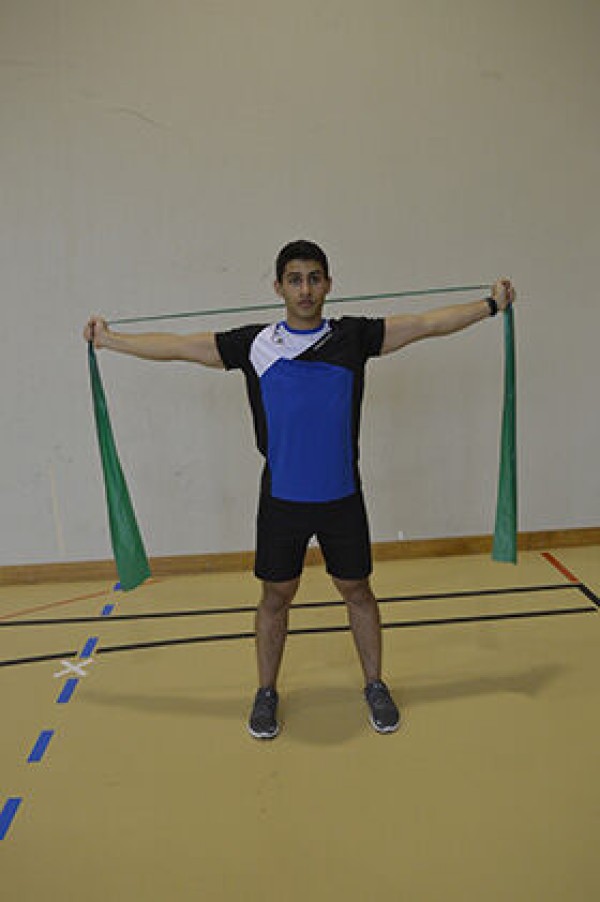
Stand upright, shoulder-width apart with your arms almost straight above your head in an upright position. Grasp the elastic band with your hands slightly wider than shoulder-width apart and, keeping your arms straight, lower your body sideways towards the T-position (squeeze your shoulder blades together) and return to the starting position.
Attention:
Do not arch your back (tense your torso), keep your shoulders deeply fixed/set.
Lighten:
Choose an elastic band with less resistance.
Harden:
Choose an elastic band with greater resistance.
1 elasticated rubber band
Lateral lowering and raising of the legs in supine position alternating ► twisting windmill / wipers
Power
Individual work
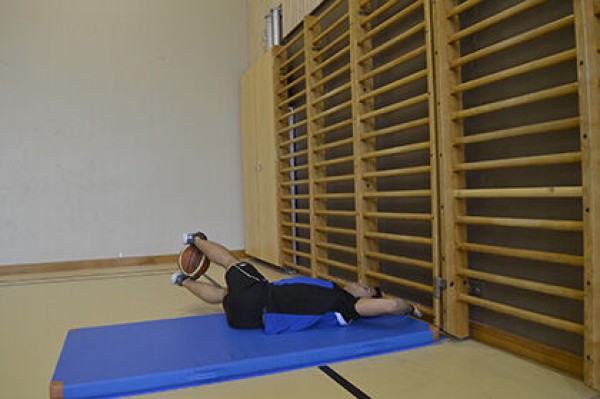
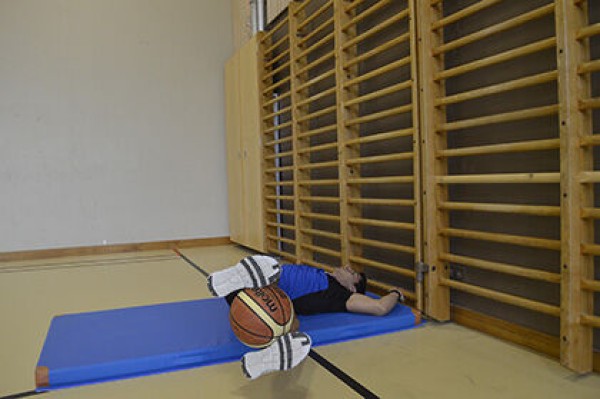
Lie on your back with your hands on a rung of the wall bars at head height. The legs are stretched out in an upright position and then moved from one side to the other towards the floor (you may need to wedge a ball between the legs).
Caution:
Do not lower your legs completely, keep them as straight as possible.
Make it easier:
Perform the exercise without the ball between your legs; lower your legs less.
Make it harder:
Add weight to your legs.
Variant:
In the centre position, lower your legs straight forwards and raise them back to the starting position.
1 wall bars
1 soft mat (small)
1 ball (e.g. football, volleyball, basketball)
2 weight cuffs/1 medicine ball ►Make the exercise more difficult (additional weight)
Lateral lowering and raising of the legs in supine position alternating ► twisting windmill / wipers
Power
Partner work

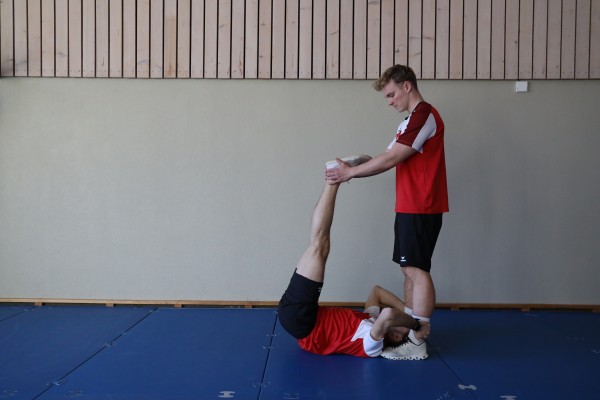
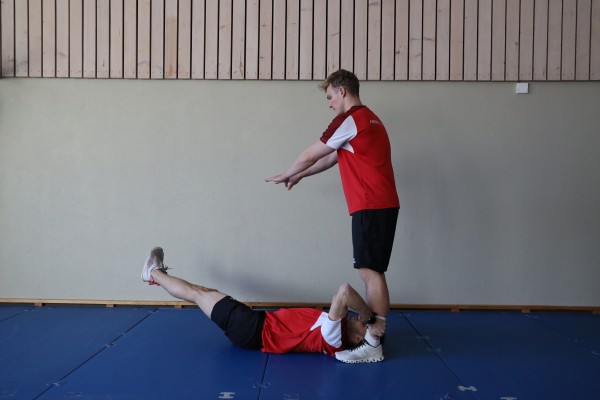
Trainee: Hold the legs of the standing partner in a supine position. Extend the legs vertically upwards and when the partner wants to push the legs towards the floor, hold against them/brake the downward movement so that the legs never touch the floor.
Partner: Hold the trainee's legs in a high position and push them sideways towards the floor.
Attention:
Always listen to/respond to your partner (adjust pressure/intensity). Keep your back in constant contact with the floor (no hollow back, consciously tense your stomach), do not put your legs down, keep your legs as straight as possible.
Lighten:
Just hold the position (legs stretched out in extension of the upper body), raise and lower your legs without additional impetus from your partner.
Harden:
Increased impulse from the partner; additional weight for the legs.
Variant:
The partner pushes the legs not only sideways but also frontally towards the floor (direction known to the exerciser or defined at random by the partner).
2 weight cuffs/ 1 (weighted) ball ► Make the exercise more difficult
Lateral lowering and raising of the legs in supine position alternating ► twisting windmill / wipers / windshield wipers
Power
Individual work

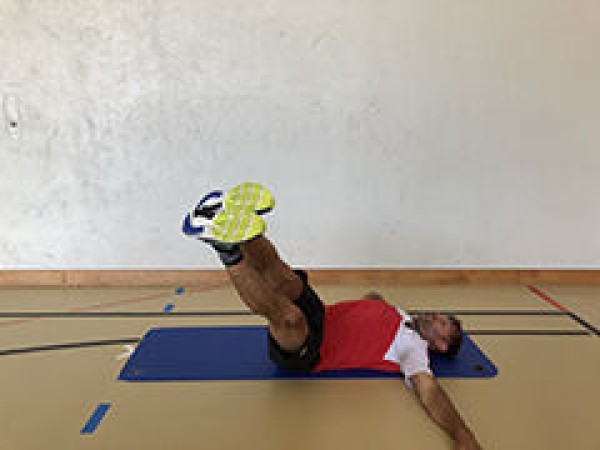
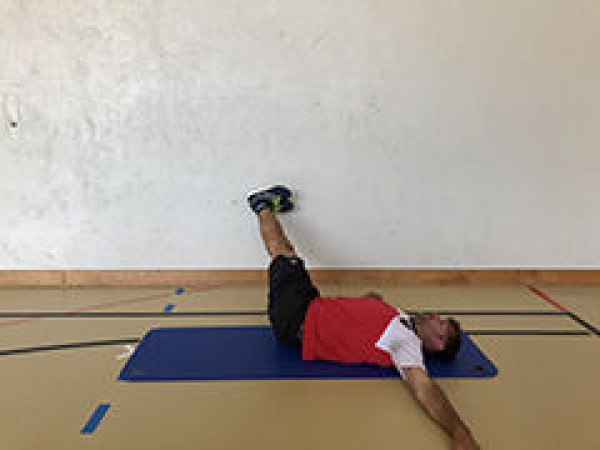
Lie on your back with your arms stretched out on the floor at shoulder height. Keep your legs together and stretched out in an upright position (pointing forwards diagonally upwards), tilt your legs alternately to the left and right side (keep your legs stretched out).
Attention:
Do not put your legs down completely, keep your back in constant contact with the floor (consciously tense your abdomen, possibly place your hands under your back to control the position).
Lighten:
Bend your legs (the closer your knees are to your body, the easier it is); lower your legs less.
Harden:
Additional weight on, between or on top of your legs.
2 weight cuffs/1 weight disc/(medicine) ball/sandbag ► Make the exercise more difficult (additional weight)
Jumping over an object from the side
Power
Individual work
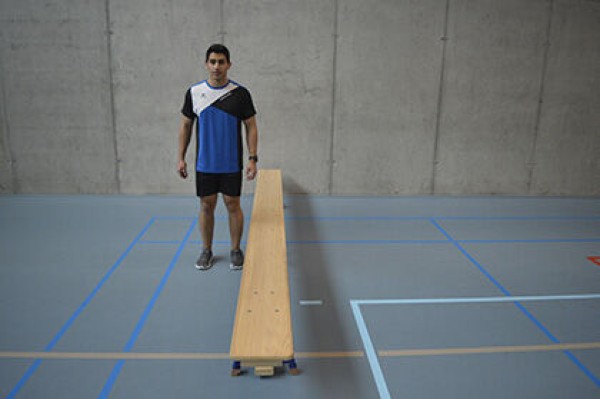
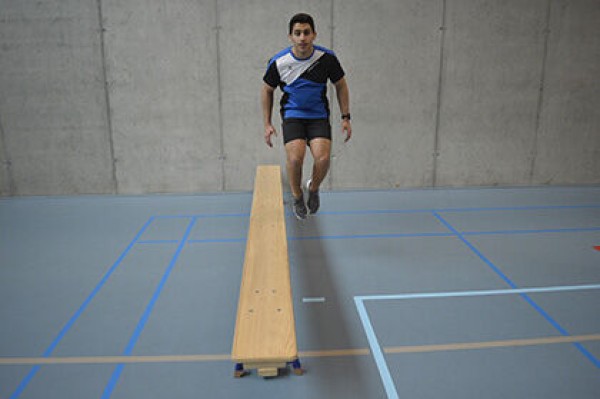
Bipedal sideways jumps from one side of the long bench to the other.
Attention:
Keep your upper body upright.
Lighten:
Jump over a line (lower jump height); lower cadence.
Harden:
Jump over a wider element (upper part of the vault box); jump over a higher element (turn vault box element on its side); jump over a wider and higher element (2 vault box elements including upper part); higher cadence; additional weight (on the feet).
Variant:
Land and jump off with the outer leg only.
1 long bench
1-2 vaulting box elements (possibly incl. top section) ► Make the exercise more difficult
2 weight cuffs/1 weight waistcoat ► Make the exercise more difficult (additional weight)
Jumping over an object from the side with the upper body supported
Power
Individual work
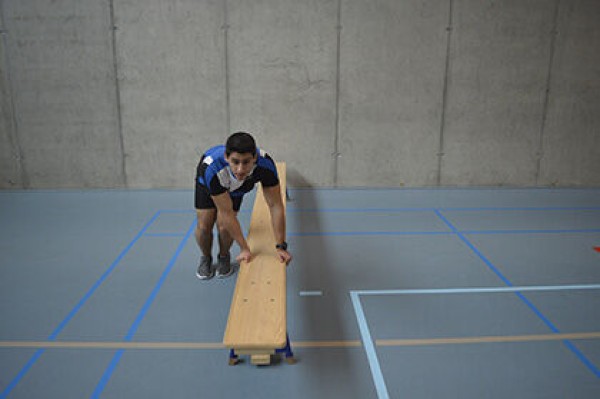
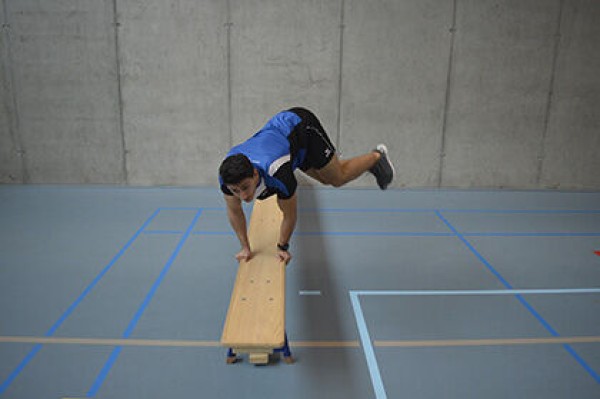
Support your upper body with your arms on the long bench/swinging box top. Jump from one side of the long bench/swinging box top to the other with both legs.
Lighten:
Deeper cadence (pauses between jumps).
Harden:
Higher cadence; additional weight (on the legs); jump over a higher element (additional vaulting box element).
Variant:
Land and jump off with the outer leg only.
1 long bench or vaulting box top
1 vaulting box element ► Make the exercise more difficult (position)
2 weight cuffs/1 weight waistcoat ► Make the exercise more difficult (additional weight)
Side support (left)
Power
Individual work

Side support with outstretched (left) arm (possibly against a wall for the correct straight position), free (right) arm supported on the hip or held upright, hold position.
Attention:
Head, torso, hips and knees form a line (pelvis does not tilt backwards or forwards).
Lighten:
Knees on the floor.
Harden:
Additional weight (on the hips); unstable support (possible for both the arm and the legs).
1 weight vest/weight disc/sandbag ► make the exercise more difficult (additional weight)
1 ball/1-2 balance cushions/1 balance board ► make the exercise more difficult (unstable surface)
Side support (left)
Power
Individual work
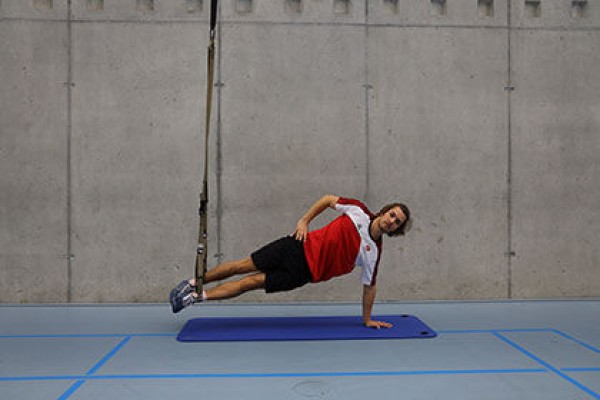
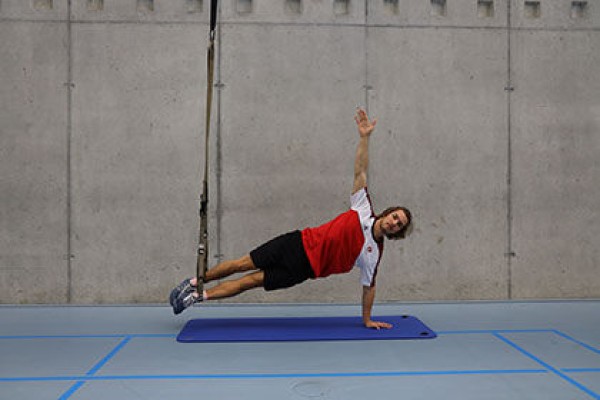
Side support on the (left) outstretched arm with the legs in the foot supports (crossed, upper leg in front). Support your upper (right) arm on your hip or extend it vertically upwards, lift your pelvis off the floor and hold the position.
Attention:
Keep your body tensed, don't let your hips sag, keep your back straight and your arm under your shoulder.
Harden:
The further away your head is from the attachment point, the more challenging the exercise becomes.
Variant I:
Lift and lower your pelvis.
Variant II:
Alternately bring your upper arm under your body and stretch it upwards, accompanying the movement with your head.
1 sling trainer
Lateral support (right)
Power
Individual work
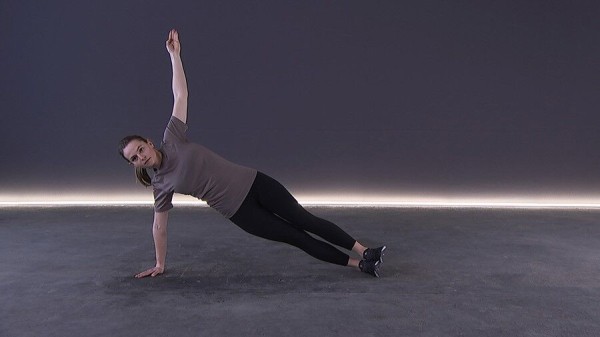
Side support with the (right) arm stretched out (possibly against a wall for the correct straight position), free (left) arm supported on the hip or held high, hold the position.
Attention:
Head, torso, hips and knees form a line (pelvis does not tilt backwards or forwards).
Lighten:
Knees on the floor.
Harden:
Additional weight (on the hips); unstable support (possible for both the arm and the legs).
1 weight vest/weight disc/sandbag ► make the exercise more difficult (additional weight)
1 ball/1-2 balance cushions/1 balance board ► make the exercise more difficult (unstable surface)
Lateral support (right)
Power
Individual work

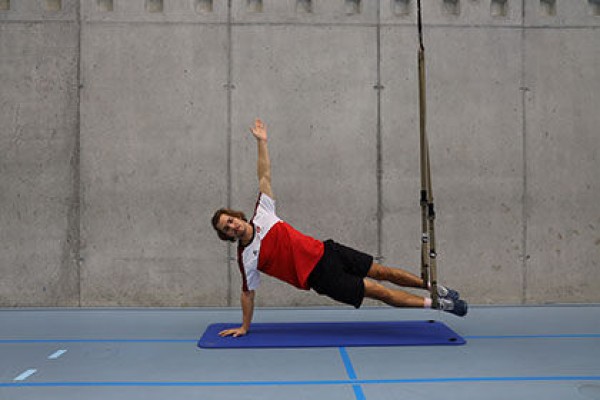
Side support on the (right) outstretched arm with the legs in the foot supports (crossed over, upper leg in front). Rest your upper (left) arm on your hip or extend it vertically upwards, lift your pelvis off the floor and hold the position.
Attention:
Keep your body tensed, do not let your hips sag, keep your back straight and your arm under your shoulder.
Harden:
The further away your head is from the attachment point, the more challenging the exercise becomes.
Variant I:
Lift and lower your pelvis.
Variant II:
Alternately bring your upper arm under your body and stretch it upwards, accompanying the movement with your head.
1 sling trainer
Lowering the shoulders on a slope (active slope) ► active hang
Power
Individual work
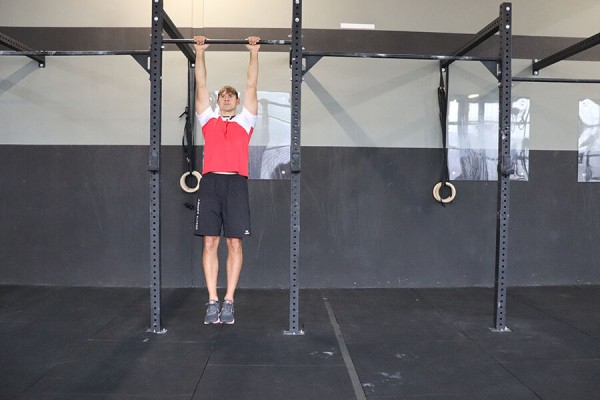
Hold on to the horizontal bar in a hanging position (full body extension, arms stretched out overhead in a high position - passive hang) (the position can be assumed with the help of a bench or a chair), the hands grasp the bar with an overhand grip (palms facing backwards), the arms are positioned shoulder-width apart. Switch from the passive to the active hang by pulling the shoulders downwards while the elbows remain stable. Hold the position for as long as possible. After the exercise, slowly place your feet back on the chair or bench before releasing your hands from the bar or dropping to the floor to stand.
Attention:
Let your upper body hang still (no swinging; tense your core muscles); arms are fully extended (no bending of the elbows); do not deliberately point your chest upwards, but try to work only in the vertical plane by pulling your shoulders downwards.
Lighten:
Do the exercise for a shorter period of time; use the elastic band as support (place one or both feet on the band).
Harden:
Additional weight.
Variant I:
Knee bent.
Variant II:
Grab the bar with a neutral grip or underhand grip (palm facing your face).
1 horizontal bar
1 elasticated rubber band ► Make the exercise easier (support)
2 weight cuffs/1 weight waistcoat ► Make the exercise more difficult (additional weight)
Lowering the upper body in the seat
Power
Individual work

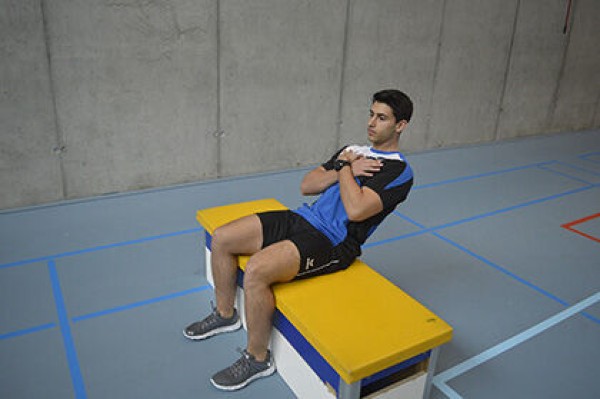
Sit upright on the Swedish box (or a long bench) with your arms folded across your chest. Lean your upper body backwards and hold the position.
Attention:
Straight back.
Lighten:
Lean your upper body less far backwards; keep your arms in front of you.
Harden:
Place your arms at an angle next to your head or even hold them up; keep additional weight on your chest.
Variant:
Change the distance between your feet and your buttocks.
2-3 vaulting box elements (incl. top section) or 1 long bench
1 weight vest/weight disc/dumbbell/sandbag ► Make the exercise more difficult (additional weight)
Lowering and raising the arms while standing
Power
Individual work
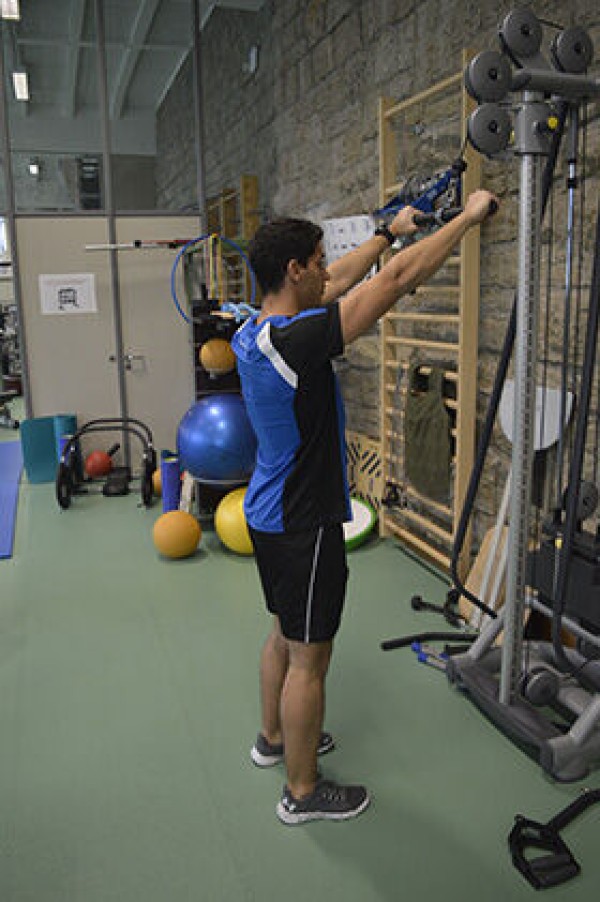
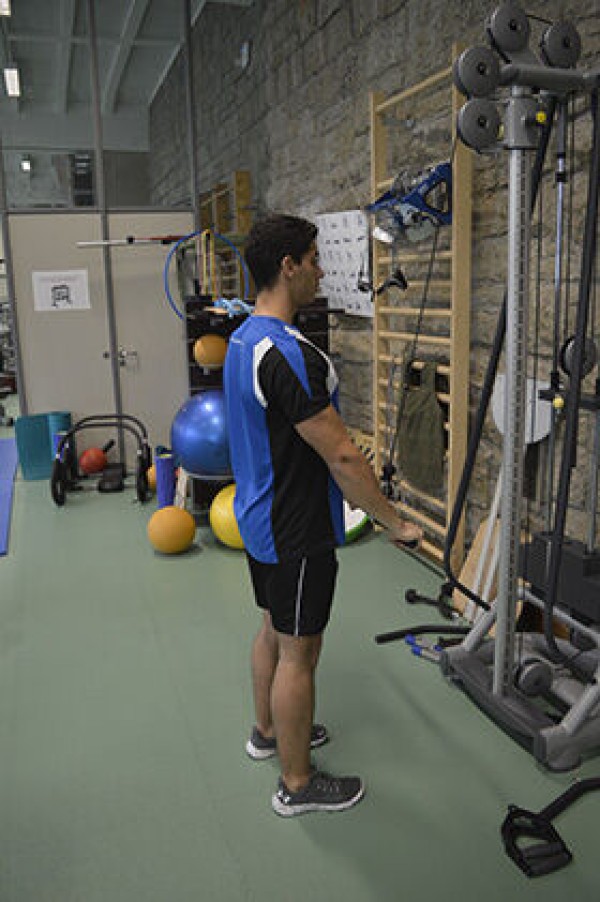
When standing, hold the bar with your hands shoulder-width apart. Keeping your arms almost outstretched, bring them down towards your thighs and back to the starting position.
Starting position:
- Stand shoulder-width apart, knees (slightly) bent
- Leg and gluteal muscles tensed
- Arms held almost straight up, hands grasping the bar with an overhand grip
Finishing position:
- Bar (almost) touching your thighs
- Arms still almost straight
Attention:
Keep your back straight throughout the exercise. The movement only comes from the shoulders, not the upper body
1 weight tower/machine ► Cable pulley (high)
Lowering and raising the arms in supine position
Power
Individual work
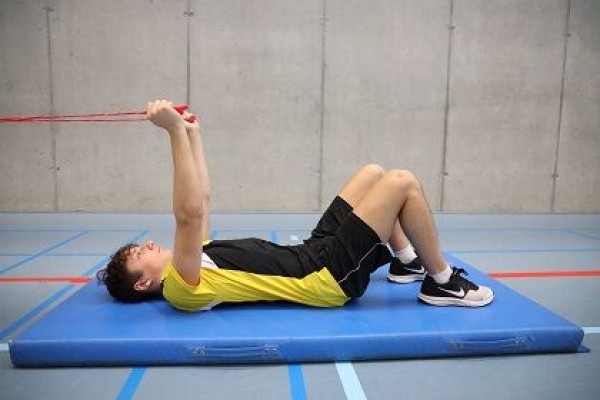
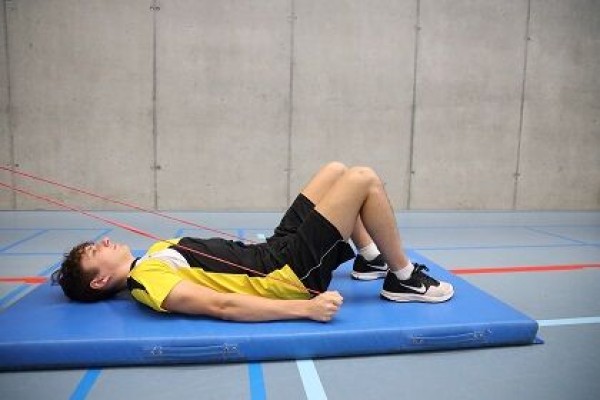
Lie on your back (head on the wall bars/tree) with your legs up and arms stretched vertically upwards. Attach the elastic band to the wall bars/tree at hand height and grasp the elastic band with your hands. Stretch your arms towards your knees and back to the starting position, with the movement only taking place in the shoulder joint.
Attention:
The upper body always remains flat on the floor.
Lighten:
Select a rubber band with less resistance.
Harden:
Select a rubber band with greater resistance.
Variation:
Pass both arms alternately left and right past the knees.
1 elasticated rubber band
1 wall bar/tree
Lowering and raising the arms in supine position
Power
Individual work
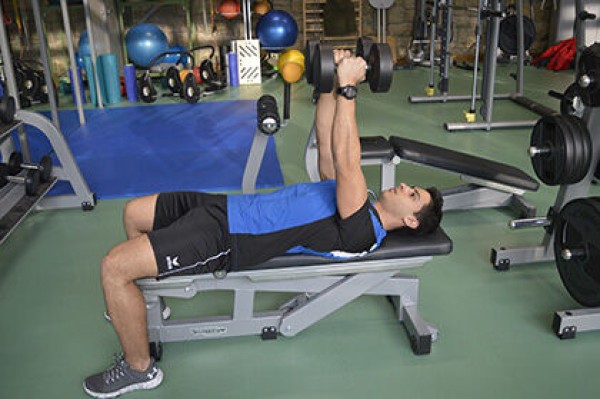
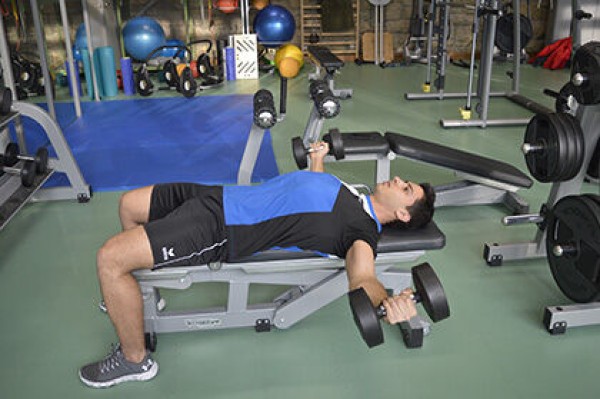
While lying on your back on the flat bench, hold the dumbbells in a neutral grip with your arms almost straight above your collarbone. With your elbows slightly bent, move the weights evenly outwards and downwards in an arc. When the dumbbells are at head height, pause briefly before pushing the weights up again.
Starting position:
- Lie on your back on the flat bench
- Arms (almost) stretched out in a high position, grasp dumbbells in a neutral grip
- Avoid a hollow back position (tense your torso)
- Legs are either bent in a high position or placed on the floor or flat bench
- The dumbbells are held in a neutral position.
Final position:
- Dumbbells are lowered in a parallel arc to head height (arms practically form a line)
Variant:
The exercise can also be performed on an incline bench. The bench should be set at an angle of around 45 degrees. The movement idea remains the same.
1 flat bench
2 dumbbells
Lowering and raising the legs in supine position ► leg raise
Power
Partner work
1 trainee & 1 helper ► Note change of position
(= double the time required; for lesson planner see Organisation Kraft: Info button Execution)
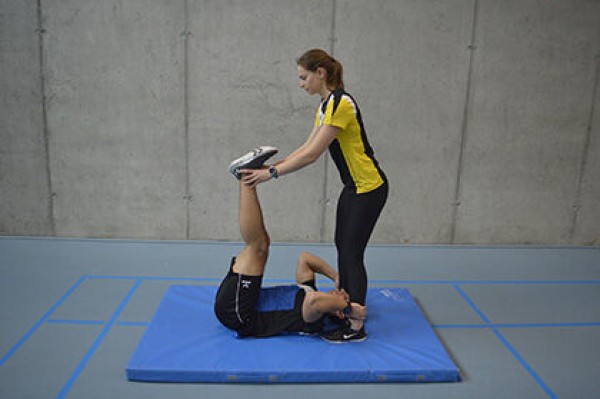

Trainee: Hold the legs of the standing partner in a supine position. Extend the legs vertically upwards and when the partner wants to push the legs towards the floor, hold against them/brake the downward movement so that the legs never touch the floor.
Partner: Hold the trainee's legs in a high position and push them towards the floor.
Attention:
Always listen to/respond to your partner (adjust pressure/intensity). Keep your back in constant contact with the floor (no hollow back, consciously tense your stomach), do not put your legs down, keep your legs as straight as possible.
Lighten:
Just hold the position (legs stretched out in extension of the upper body), raise and lower your legs without additional impulse from your partner.
Harden:
Increased impulse from the partner; additional weight for the legs.
Variant:
The partner pushes the legs not only straight towards the floor but also to the side (direction known to the exerciser or arbitrarily defined by the partner).
2 weight cuffs/ 1 (weighted) ball ► Make the exercise more difficult
Lowering and raising the upper body while kneeling
Power
Individual work
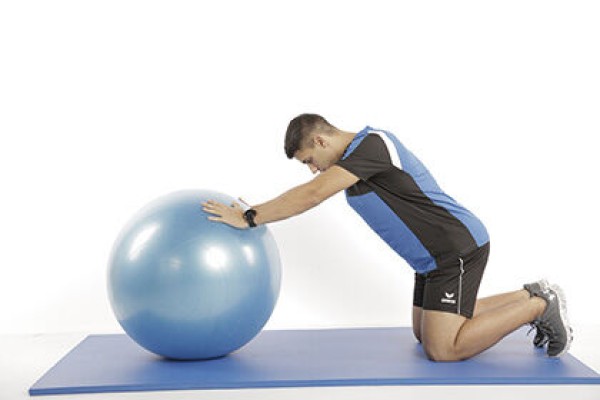
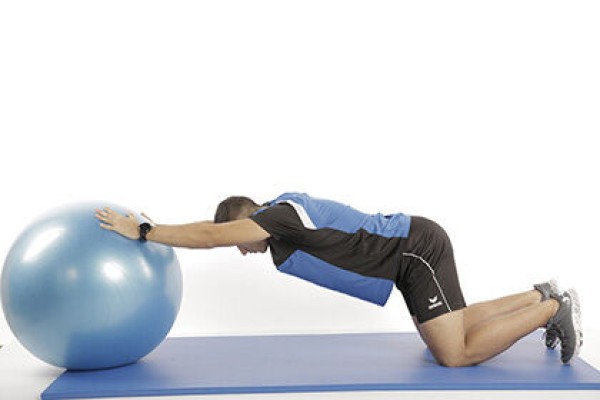
Kneeling (buttocks not resting on your heels, right angle at the knees), support your upper body with your hands on the exercise ball. Roll the exercise ball forwards and back to the starting position and move your upper body with it.
Attention:
Do not fall into a hollow back (actively tense your torso).
Lighten:
Roll the ball less forwards.
Harden:
Lift your knees.
1 exercise ball
Lowering and raising the upper body while kneeling
Power
Partner work
1 trainee & 1 helper ► Note change of position
(= double the time required; for lesson planner see Organisation Kraft: Info button Execution)
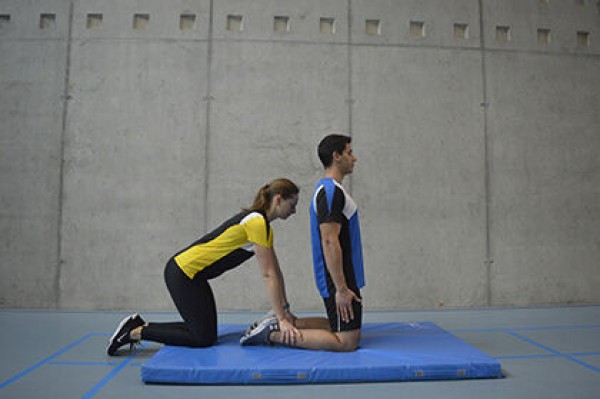
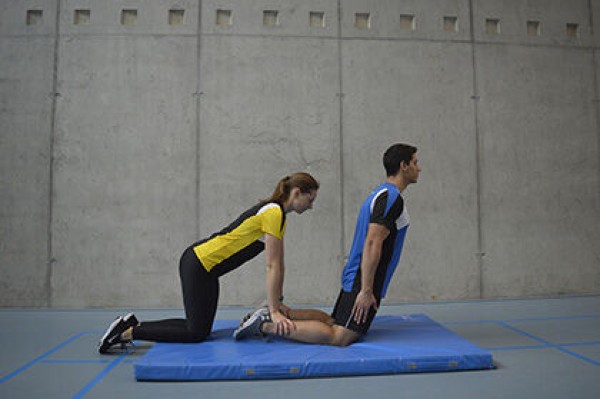
Exerciser: Kneeling with the upper body upright (approx. 90 degrees at the knee joint, no sitting on the heels) and arms folded across the chest. Tilt your upper body forwards as far as possible and straighten up again (movement in the knee joint).
Partner: Hold the legs of the active participant.
Attention:
Straight back.
Lighten:
Just hold the position (the more upright the position, the easier); arms point backwards to the side of the body.
Harden:
Place your arms at an angle next to your head or hold them up; hold additional weight (on your chest).
Variant:
Slowly tilt your upper body forwards as far as possible until you support any fall with your hands.
1 weight disc ► Make the exercise more difficult (additional weight)
Lowering and raising the upper body while kneeling ► Abdominal crunch
Power
Individual work
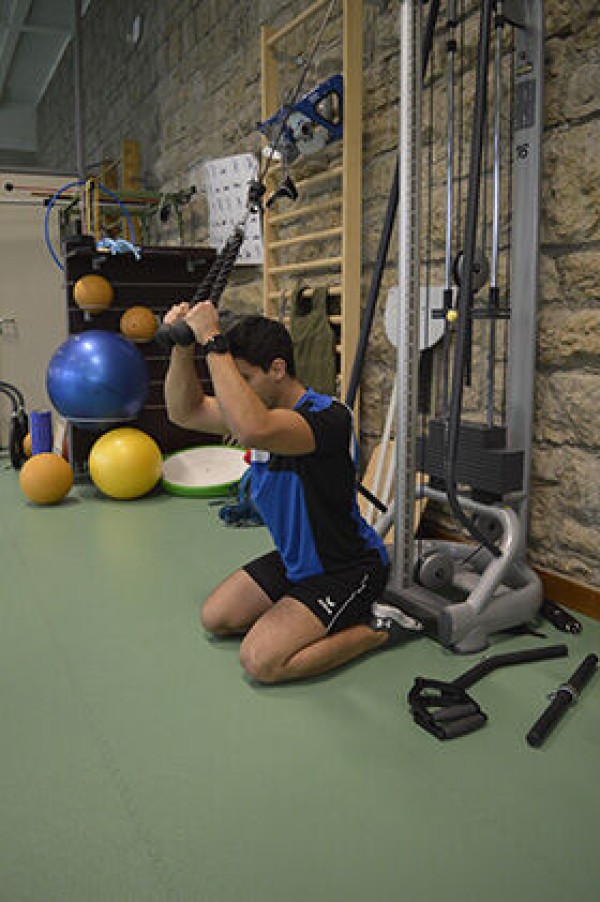
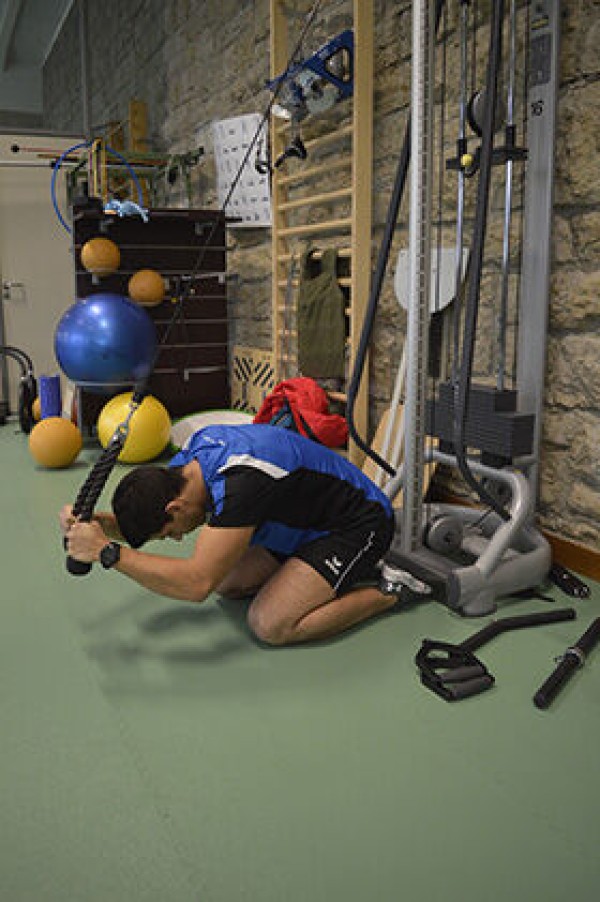
Stand on your knees with your upper body slightly bent forward in front of the high cable pulley (both positions are possible: facing towards or away from the cable pulley). Build up strength in your core and curl your upper body in a controlled manner. When raising the upper body, work slowly and in a controlled manner until the back is stretched out again.
Starting position:
- Kneel, upper body slightly bent forward
- Hold the cable pulley at head height with both hands and bent arms
Finishing position:
- Pull your elbows and head towards your knees
- Roll up your upper body
Attention:
Do not work with momentum. Only work with as much weight as you can control. It is best to train the technique without weight first. Keep your core tensed the whole time and don't fall into a hollow back.
1 weight tower/machine ► Cable pulley (high)
Lowering and raising the upper body while kneeling ► ghd glute ham raise
Power
Individual work
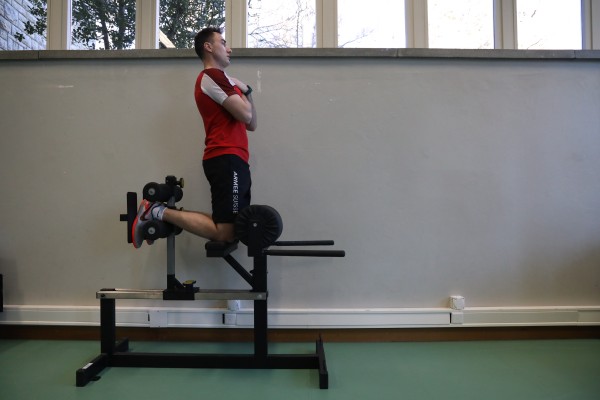
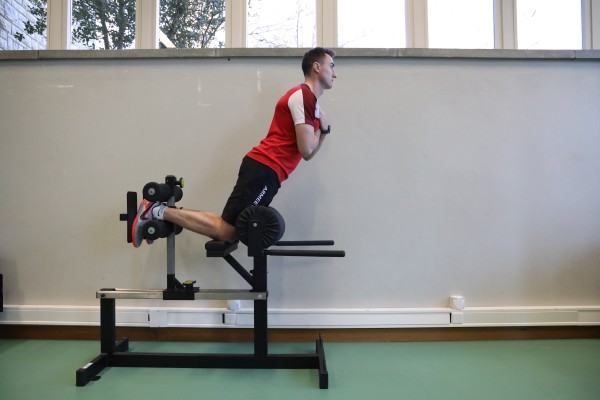
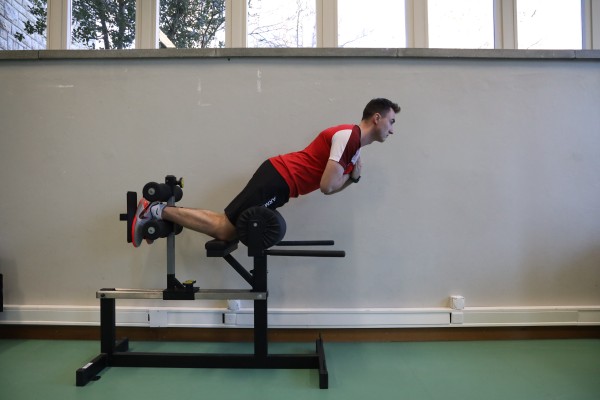
In a kneeling position on the back of the padding with the upper body upright, fix the feet in the holder (feet pointing downwards), hold the arms on the chest or cross them, tense the abdominal muscles, do not overstretch the spine (straight back). Lower your upper body until it is parallel to the floor (horizontal). To lower, push your knees behind the pad. Depending on the training level, the upper body can also be lowered less far or even lower. Once you have reached the end position (with legs straight), bend your legs and tense your gluteal muscles to return to the starting position on your knees.
Attention:
Keep your back straight (tense your core).
Lighten:
Lower your upper body less (not all the way to horizontal); training partner for support.
Harden:
Lower your upper body beyond horizontal; additional weight (on your chest).
1 glute-ham developer (GHD)
1 weight disc ► to make the exercise more difficult (additional weight)
Lowering and raising the upper body in the seat
Power
Individual work
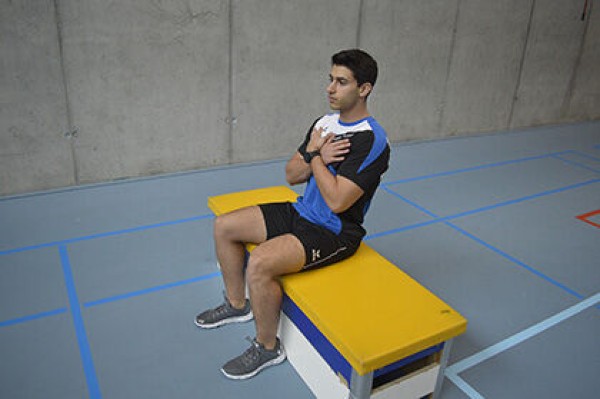
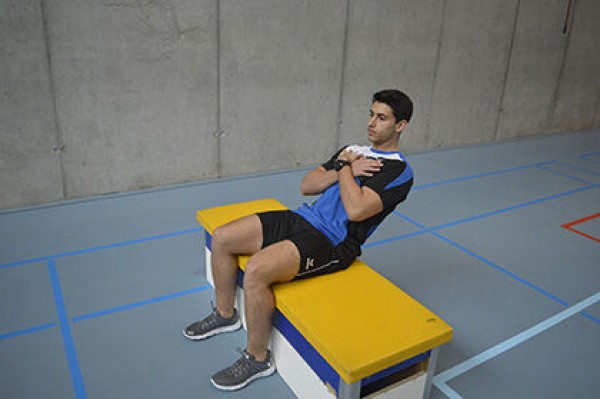
Sit upright on the Swedish box (or a long bench) with your arms folded across your chest. Lower your upper body backwards and straighten up (do not fully return to the starting position).
Attention:
Straight back, constant tension in the abdominal muscles, head in a neutral position (no double chin).
Lighten:
Lean your upper body less far back; keep your arms forward.
Harden:
Place your arms at an angle next to your head or even hold them up; keep additional weight on your chest.
Variant:
Change the distance between your feet and buttocks.
2-3 vaulting box elements (incl. top section) or 1 long bench
1 weight vest/weight disc/dumbbell/sandbag ► Make the exercise more difficult (additional weight)
Lowering and raising the upper body in the seat
Power
Individual work
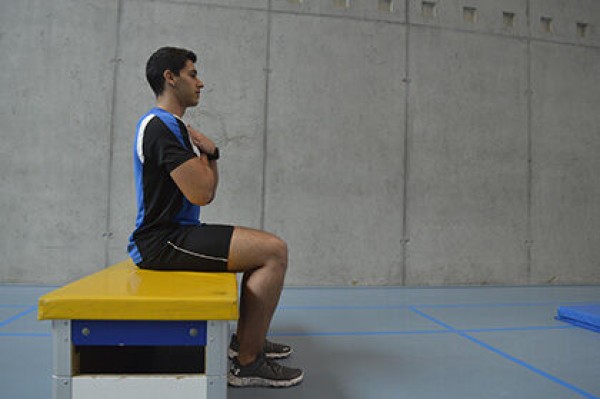
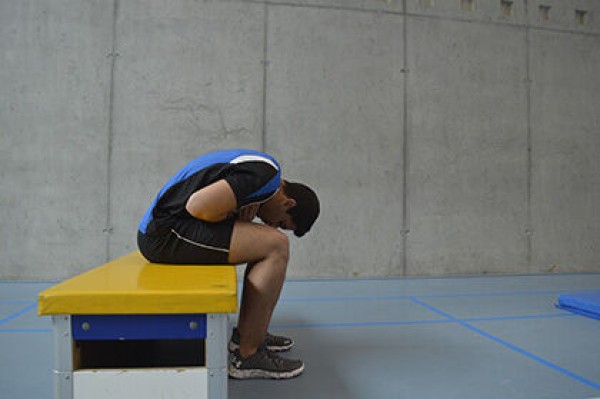
Sit on the Swedish box (or a long bench) with your arms folded across your chest. Bend your upper body forwards and return to the starting position.
Attention:
Start stretching consciously in the lower back and try to stretch vertebra by vertebra, rolling back in from the head.
Lighten:
Support your arms on the top of the swinging box.
Harden:
Bend your arms next to your head (hands on your neck) or hold them up; keep additional weight on your chest.
2-3 vaulting box elements (incl. top section) or 1 long bench
1 weight disc/dumbbell/sandbag ► Make the exercise more difficult (additional weight)
Lowering and raising the upper body while seated ► Abdominal crunch
Power
Individual work
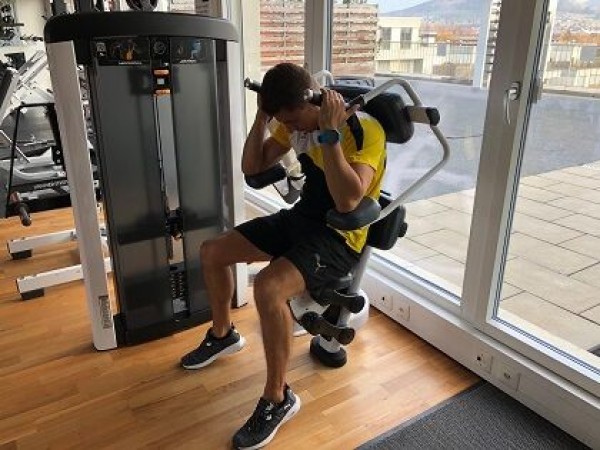
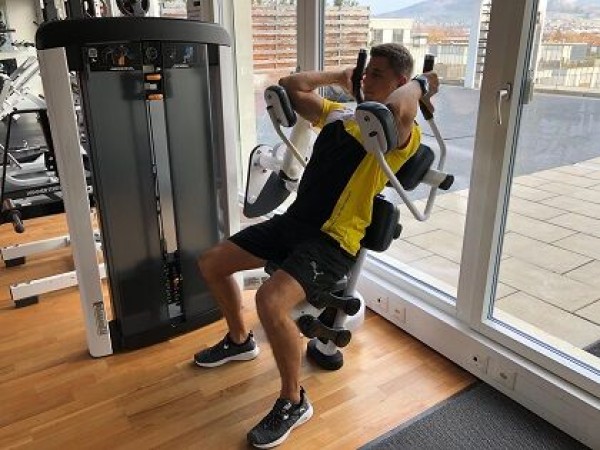
Grab the handles behind your head and position your elbows on the cushions, tense your core muscles and pull your upper body down towards your legs, then raise your upper body back up to the starting position.
Starting position:
- Sitting with the upper body slightly overstretched
- Grasp the handles with your hands behind your head
- Rest your elbows on the cushion
Finishing position:
- Grip unchanged
- Bring your upper body closer to your legs
Attention:
Work from the core muscles, which means that you should not pull with your hands or push with your elbows.
Lowering and raising the upper body in the seat ► back extension / lower back
Power
Individual work
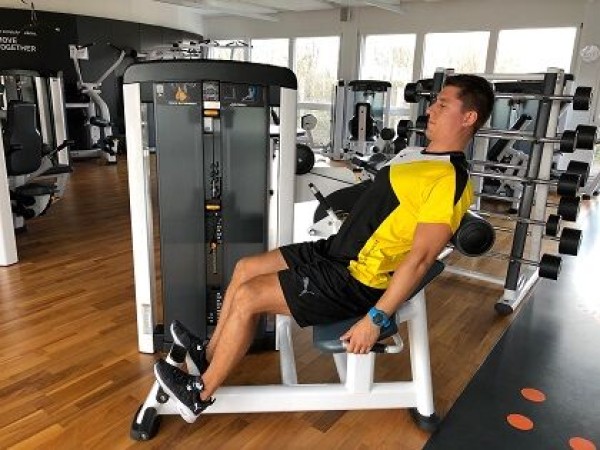

Place the shoulder blades on the cushion, push the upper body backwards from the forward-leaning position against the resistance while sitting, using the thigh and buttock muscles to support the lower back.
Starting position:
- Sitting with the upper body leaning forwards
- Straight back stretched out
Finishing position:
- Upright posture or upper body leaning backwards
- Position of the back unchanged
Lowering and raising the upper body while standing
Power
Individual work
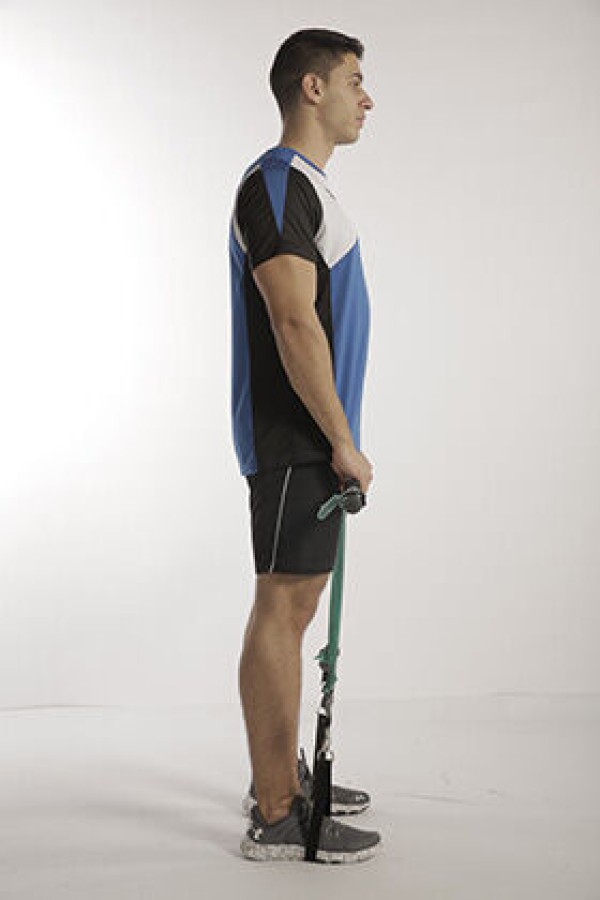
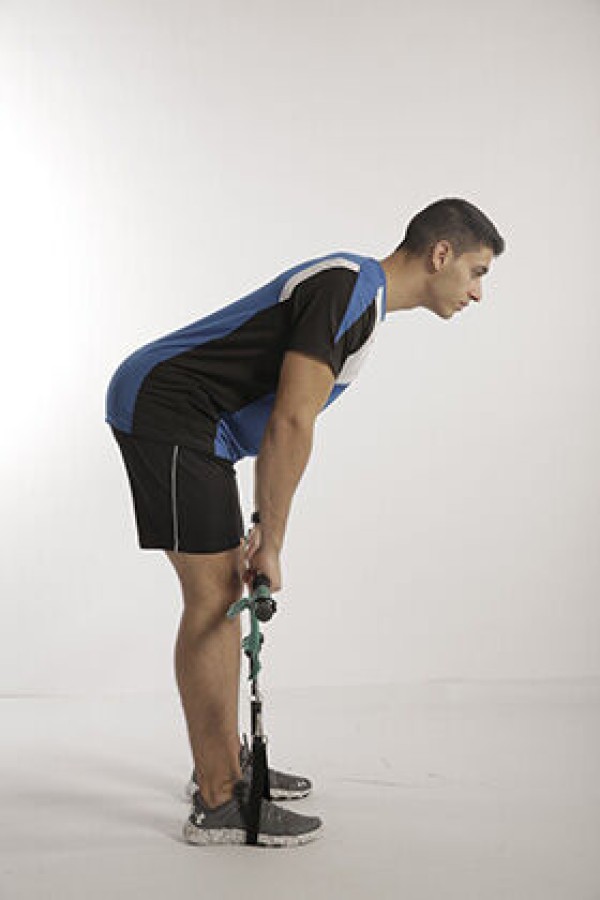
Stand upright, shoulder-width apart with your feet in the loops. Hold the gymnastics pole with outstretched arms in an overhand grip slightly wider than hip-width in front of your body (back of hands pointing forwards), tilt your upper body forwards with a straight back and bend your knees slightly. Stretch your legs and straighten your upper body again to return to the starting position.
Attention:
The movement takes place in the hip joint, move the gymnastics bar close to your body, keep your back straight.
Lighten:
Choose less strong elastic bands; roll up the elastic bands less.
Harden:
Choose stronger elastic bands; roll up the elastic bands more.
Variation:
Hold the gymnastics bar on your shoulders behind your head (longer lever).
1 gymnastic bar with elasticated straps